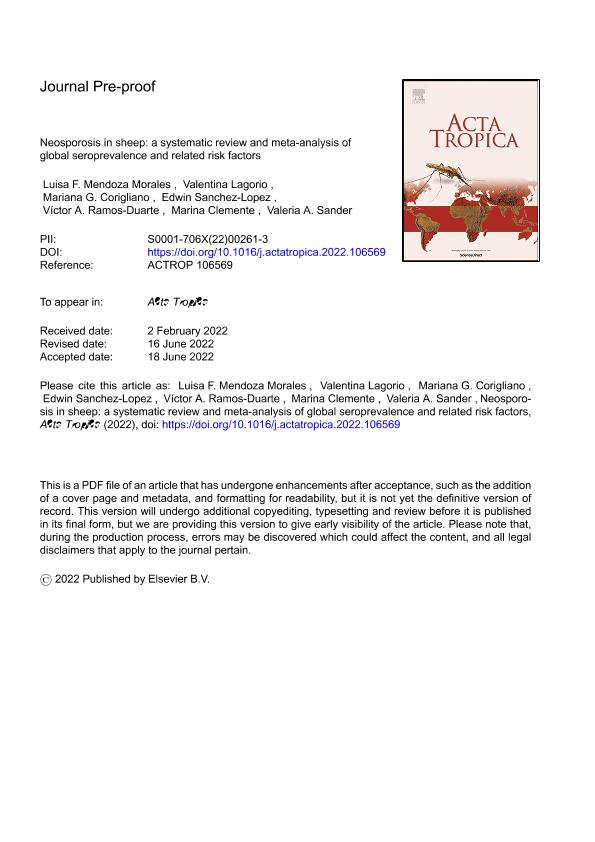Artículo
Neosporosis in sheep: A systematic review and meta-analysis of global seroprevalence and related risk factors
Mendoza Morales, Luisa Fernanda ; Lagorio, Valentina; Corigliano, Mariana Georgina
; Lagorio, Valentina; Corigliano, Mariana Georgina ; Sánchez López, Edwin Fernando
; Sánchez López, Edwin Fernando ; Ramos Duarte, Víctor Andrés
; Ramos Duarte, Víctor Andrés ; Clemente, Marina
; Clemente, Marina ; Sander, Valeria Analía
; Sander, Valeria Analía
 ; Lagorio, Valentina; Corigliano, Mariana Georgina
; Lagorio, Valentina; Corigliano, Mariana Georgina ; Sánchez López, Edwin Fernando
; Sánchez López, Edwin Fernando ; Ramos Duarte, Víctor Andrés
; Ramos Duarte, Víctor Andrés ; Clemente, Marina
; Clemente, Marina ; Sander, Valeria Analía
; Sander, Valeria Analía
Fecha de publicación:
06/2022
Editorial:
Elsevier Science
Revista:
Acta Tropica
ISSN:
0001-706X
Idioma:
Inglés
Tipo de recurso:
Artículo publicado
Clasificación temática:
Resumen
Neosporosis is recognized as the main cause of abortions in cattle worldwide and there is an increasing concern about its role in ovine reproductive losses; however, epidemiological studies regarding neosporosis in sheep are still limited. This meta-analysis aimed to estimate the global pooled seroprevalence and associated risk factors of ovine neosporosis. In the current report, a comprehensive strategy of search and data collection from 7 worldwide databases was performed. A final set of 73 studies (80 datasets) published from 2000 to 2021 were selected based on inclusion criteria, comprising data on 35,740 sheep (corresponding to 37,565 evaluated samples) from 30 countries worldwide. The global pooled seroprevalence of Neospora caninum infection in sheep estimated by the random-effects model was 13% (95% CI, 10-15) and showed high heterogeneity (Q = 5147.15, I2 = 98%, p< 0.001). Furthermore, by meta-analyses of subgroups it was demonstrated for the first time that seroprevalence significantly varied between continents (highest in Africa; 20%, 95% CI, 4-44), WHO regions (highest in African Region; 42%, 95% CI, 36-48), countries (highest in Colombia; 79%, 95% CI, 61-92%) and diagnostic methods (highest by IFAT; 17%, 95% CI, 12-23). Meta-regression indicated significant increasing trends in the prevalence of ovine neosporosis with decrease in geographical latitude (coefficient = -0.013; p<0.001), whereas longitude did not influence it (coefficient = -0.001; p=0.365). Regarding associated risk factors, older sheep were more likely to be infected with N. caninum than younger ones (OR 1.42; 95% CI 1.08–1.87), and sheep bred under intensive or semi-intensive systems resulted less susceptible to be seropositive than those bred under extensive system (OR 0.65; 95% CI 0.42-0.99 and OR 0.74; 95% CI 0.62–0.89, respectively). Conversely, no apparent association was found between seroprevalence and other variables, such as sex (OR 1.06; 95% CI 0.9–1.24), the presence of dogs on the farm (OR 1.15; 95% CI 0.63–2.12) or the presence of abortion (OR 1.80; 95% CI 0.87–3.74). In conclusion, the seroprevalence of ovine neosporosis is widely and heterogeneously distributed throughout the world, and it is negatively associated with increasing geographical latitude. In addition, age and extensive production system represent risk factors, which suggest that the horizontal transmission route is relevant for this host species. It is recommended to pay more attention to this disease and emphasize the global need for more indexed studies concerning the seroprevalence and risk factors of ovine neosporosis to better understand the epidemiology of this coccidian infection.
Palabras clave:
EPIDEMIOLOGY
,
META-ANALYSIS
,
NEOSPOROSIS
,
ODDS RATIO
,
OVINE
,
OVIS ARIES
,
PREVALENCE
Archivos asociados
Licencia
Identificadores
Colecciones
Articulos(CCT - LA PLATA)
Articulos de CTRO.CIENTIFICO TECNOL.CONICET - LA PLATA
Articulos de CTRO.CIENTIFICO TECNOL.CONICET - LA PLATA
Articulos(IIB-INTECH)
Articulos de INST.DE INVEST.BIOTECNOLOGICAS - INSTITUTO TECNOLOGICO CHASCOMUS
Articulos de INST.DE INVEST.BIOTECNOLOGICAS - INSTITUTO TECNOLOGICO CHASCOMUS
Citación
Mendoza Morales, Luisa Fernanda; Lagorio, Valentina; Corigliano, Mariana Georgina; Sánchez López, Edwin Fernando; Ramos Duarte, Víctor Andrés; et al.; Neosporosis in sheep: A systematic review and meta-analysis of global seroprevalence and related risk factors; Elsevier Science; Acta Tropica; 233; 6-2022; 1-66
Compartir
Altmétricas



